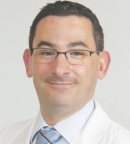LISOCABTAGENE MARALEUCEL (Liso-cel; JCAR017), a CD19-directed chimeric antigen receptor (CAR) T-cell therapy with defined composition, has shown “potent and durable” responses in poor-prognosis patients with relapsed or refractory aggressive non-Hodgkin lymphoma (NHL) in a phase I trial.1 According to data presented at the 2018 ASCO-SITC Clinical Immuno-Oncology Symposium, toxicities were also manageable at all dose levels tested, with low rates of severe cytokine-release syndrome (1%) and neurotoxicity (12%).

Jeremy S. Abramson, MD
“Based on encouraging, durable responses in the core population, we have begun enrollment in the pivotal cohort of diffuse large B-cell lymphoma,” said Jeremy S. Abramson, MD, Clinical Director of the Center for Lymphoma at the Massachusetts General Hospital Cancer Center. “The favorable safety profile of this product also allows for outpatient administration, which we are continuing to evaluate in the next phase of the study.”
As Dr. Abramson explained, relapsed or refractory aggressive B-cell NHL is associated with a particularly poor prognosis and a high unmet need. Patients with chemotherapy-refractory disease have a median overall survival of less than 6 months with available therapies and a complete response rate of less than 20%.
JCAR017 is a CD19-directed CAR T-cell product consisting of individually formulated CD4-positive and CD8-positive cell suspensions. As Dr. Abramson reported, a patient’s cells undergo immunomagnetic selection, followed by lentivirus transduction, expansion, and formulation at specified composition of CD4-positive and CD8-positive CAR T cells, which are then administered in a precise, flat dose. Although CD8-positive and CD4-positive CAR T cells target the tumor, the latter also support persistence of the treatment.
TRANSCEND NHL 001 Trial
THIS MULTICENTER, seamless-design, pivotal trial included both dose-finding and dose-expansion cohorts. Dose level 1S included 5 × 107 cells in a single dose, dose level 1D included 5 × 107 cells in a double dose, and dose level 2 included 1 × 108 cells in a single dose. Patients included in a “core” population had diffuse large B-cell lymphoma, transformed follicular lymphoma, or high-grade double- or triple-hit lymphomas after two lines of therapy. The full cohort also included patients with primary mediastinal B-cell lymphoma and follicular lymphoma grade 3B and patients with aggressive lymphoma that had transformed from chronic lymphocytic leukemia or marginal zone lymphoma.
As Dr. Abramson reported, 140 patients underwent leukapheresis in the diffuse large B-cell lymphoma cohort, and JCAR017 was available for 98% of patients (126 of 128). There were only 2 cases of manufacturing failure, he said, adding that 108 patients have been treated to date with JCAR017 following lymphodepletion with fludarabine and cyclophosphamide.
High-Risk Patient Population
OF THE 91 patients evaluable for safety, 67% were refractory to chemotherapy, and the median age of the full cohort was 61 years. Most patients (89%) had an Eastern Cooperative Oncology Group performance status of 0 or 1; Dr. Abramson emphasized this was a heavily pretreated population, with a median of 3 prior lines of therapy and up to 12 prior treatments.
“Half of patients have never achieved a complete response prior to going on study, and 43% had a prior stem cell transplant,” said Dr. Abramson, who noted that approximately 90% of treated patients had at least 1 poor-risk disease feature predictive of a median overall survival of between 3 and 6 months.
Toxicity
MOST PATIENTS experienced at least 1 treatment-related adverse event, and 60% of patients experienced an adverse event related to JCAR017. The most common treatment-related adverse event was neutropenia, followed by thrombocytopenia and anemia. Beyond these events, however, toxicities were uncommon, said Dr. Abramson, with very few grade 3/4 events reported. Dr. Abramson also highlighted the low rate of cytokine-release syndrome (35%), noting that only 1 of 91 evaluable patients had severe cytokine-release syndrome.
In addition, neurotoxicity was seen in 19% of patients, with 12% experiencing grade 3 or 4 neurotoxicity. There were no deaths from cytokine-release syndrome or neurotoxicity and no cases of cerebral edema, said Dr. Abramson, who noted low levels of tocilizumab (Actemra) use (12%) and dexamethasone use (16%). According to Dr. Abramson, the low rates of toxicity and late-onset support the outpatient administration of this product.
“Thus far, 8 patients have been treated as outpatients at least 28 days post infusion, and 1 patient remained outpatient throughout the duration of the dose-limiting toxicity period,” said Dr. Abramson. None of the eight patients treated as outpatients required ICU admission, he added.
Responses Seen in All Subgroups
THE OVERALL response rate was 74% for the entire patient population, and 52% of patients had a complete response. The investigators also observed a dose-response relationship. Patients in the core group treated with the smaller dose (5 × 107 cells in a single dose) had an overall response rate of 76% and a complete response rate of 47%. In comparison, those treated with dose level 2 (1 × 108 cells in a single dose) had an overall response rate of 81% and a complete response rate of 63%.
“Half of those who had a complete response with dose level two with 6 months of follow-up remain in complete remission,” said Dr. Abramson, who noted responses were also seen across all high-risk subgroups, including transformed follicular lymphoma (76.9%), stage III/IV disease (62.2%), chemorefractory disease (64.9) and double/triple-hit lymphoma (84.6%).
In addition, early overall survival data “compare favorably” in this high-risk population with what is seen with available therapies, said Dr. Abramson. The median overall survival was not reached in the full cohort, and the 6-month overall survival was 86%. In those who achieved a complete response, the median was not reached, and the 6-month overall survival was 94%.
When combined with a manageable safety profile, these potent and durable remissions are promising in this high-risk malignancy,” said Dr. Abramson, who noted a subsequent pivotal cohort using dose level two is now enrolling patients and will include patients with diffuse large B-cell lymphoma alone.
‘How Durable Are These Responses?’

Stephen Gottschalk, MD
DISCUSSANT OF the session, Stephen Gottschalk, MD, of St. Jude Children’s Research Hospital, commended the research but said questions still remain regarding the use of CD19-targeted CAR T-cell therapy in NHL. “The most important question is how durable are these responses? But to answer that, longer follow-up is needed,” he said.
“We’d also like to understand the mechanism of failure. In acute lymphoblastic leukemia, CD19-negative immune escape has been very well documented, but that is not the case in NHL. Finally, in patients who do achieve a long-term complete response, when is it safe to deplete CD19 CAR T cells to allow the recovery of normal B cells?” ■
DISCLOSURE: Dr. Abramson has served as an advisor or consultant for Celgene, Genentech/Roche, Gilead Sciences, Novartis, and Seattle Genetics and has received research funding from Celgene, Genentech, Millennium, and Seattle Genetics. Dr. Gottschalk has served as an advisor or consultant for AbbVie, Celgene, Immatics, and Merrimack. He has filed patent applications focused on cell therapy for cancer, oncolytic viruses, and cancer gene therapy.
REFERENCE
1. Abramson JS, Siddiqi T, Palomba ML, et al: High durable CR rates and preliminary safety profile for JCAR017 in R/R aggressive b-NHL (TRANSCEND NHL 001 Study): A defined composition CD19-directed CAR T-cell product with potential for outpatient administration. 2018 ASCO-SITC Clinical Immuno-Oncology Symposium. Abstract 120. Presented January 26, 2018.

